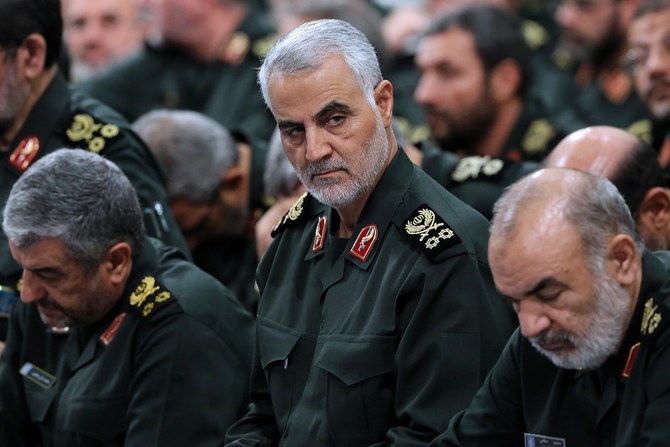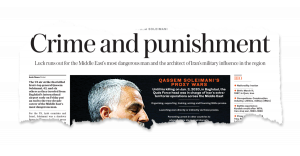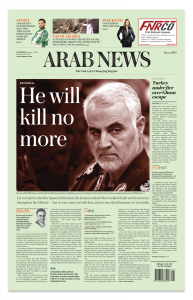- ARAB NEWS
- 14 Jul 2025

Dr. Majid Rafizadeh
Summary
On Jan. 3, 2020, missiles from a US Reaper drone struck two vehicles leaving Baghdad International Airport, killing Qassem Soleimani, the feared commander of Iran’s clandestine Quds Force, and nine others.
For over two decades Soleimani had been the architect of Iran’s violent meddling throughout the region, responsible for countless thousands of deaths in Iraq, Syria, Yemen and elsewhere.
In the words of an Arab News editorial the day after his death, in “spreading the malign influence of the mullahs and their revolution to anyone foolish enough to listen” Soleimani had “brought death and destruction to a vast swath of the Middle East and beyond.”
When death came in turn for Soleimani, accused by the US of being behind a series of attacks on American interests in Iraq, those who died alongside him included four other members of Iran’s Islamic Revolutionary Guards Corps and Abu Mahdi Al-Muhandis, commander of the Iranian-backed Iraqi terrorist organization Kata’ib Hezbollah.
US President Donald Trump on Jan. 3 this year ordered a game-changing military attack that killed Iranian Maj. Gen. Qassem Soleimani, head of the elite Quds Force, near Baghdad International Airport. Soleimani was accompanied by Iraqi militia leaders, including Abu Mahdi Al-Muhandis, who was also killed in the attack. The US Department of Defense justified the attack by claiming that Soleimani “was actively developing plans to attack American diplomats and service members in Iraq and throughout the region.”
The death of Soleimani marked the first time that the US had deliberately killed a top Iranian official. Without doubt, the move shocked and weakened the theocratic establishment of Iran, as Soleimani was considered the country’s most powerful man after Supreme Leader Ali Khamenei.
It is virtually impossible to imagine that the Islamic Republic could have gained such influence in the region and built such a vast and mighty network of proxies, militias and terror groups without Soleimani. The general even admitted, when he wrote a rare message to US Gen. David Petraeus: “You should know that I, Qassem Soleimani, control the policy for Iran with respect to Iraq, Lebanon, Gaza, and Afghanistan. And indeed the ambassador in Baghdad is a Quds Force member. The individual who is going to replace him is a Quds Force member.”
The death of Soleimani has had significant implications in the region, tipping the balance of power against Tehran and ridding the Middle East of a top terror leader.
For many in the region, Soleimani was no different to Osama bin Laden. In fact, he was more dangerous in some respects because he operated under the legitimacy of a state, ruled over a powerful military organization with tens of thousands of members, and had a budget of billions of dollars to advance his fundamentalist objectives.
Soleimani reportedly meets with militia allies in Baghdad to plan fresh assaults on US interests in Iraq using Iranian-supplied rockets and missiles.
A US contractor dies in a rocket attack on the K-1 airbase in Kirkuk, Iraq, one of a series of attacks in Iraq blamed by Washington on the Iranian-backed Kata’ib Hezbollah militia.

US counter-attacks on five Kata’ib Hezbollah bases in Iraq and Syria kill 25 militiamen, including several senior commanders.

Kata’ib Hezbollah supporters attempt to storm the US embassy compound in Baghdad. President Donald Trump holds Iran “fully responsible.”
With “clear, unambiguous intelligence” that Soleimani had approved the Kirkuk rocket attack and was planning a series of further outrages, Trump approves a drone strike.
Soleimani and nine others die in a US drone strike in Baghdad.
Iran fires missiles at two airbases in Iraq where US forces are stationed. There are no casualties. However, a Ukrainian airliner leaving Tehran for Kiev is shot down.

Anti-government protesters in Tehran call for leaders to quit after Iran admits its forces shot down Ukraine International Airlines Flight 752 by accident.

Soleimani was masterful in carrying out extraterritorial operations, including organizing, supporting, training, arming and financing predominantly Shiite militia groups. He prioritized launching wars directly or indirectly via his proxies; fomenting unrest in other nations to advance the regime’s ideological and hegemonic interests; attacking and invading cities and countries; and plotting the assassination of foreign political figures and powerful Iranian dissidents worldwide.

“So let there be no tears shed for Qassem Soleimani; he must have known that he could not get away with his crimes forever, and that he would not die in his bed.”
Faisal J. Abbas in Arab News, Jan. 4, 2020
For example, under his leadership, the Quds Force was accused of failed plans to bomb the Saudi and Israeli embassies in the US, and to assassinate then-Saudi Ambassador to the US Adel Al-Jubeir. The Quds Force also encouraged unrest in Iraq by providing deadly, sophisticated bombs that killed many people, including Iraqis and Americans. An investigation also revealed that Soleimani’s Quds Force was behind the 2005 assassination of Lebanon’s Sunni Prime Minister Rafik Hariri.
In addition, Soleimani’s death undermined other non-Shiite extremist groups in the region because he was successful at making alliances with the likes of Al-Qaeda. For instance, while under Soleimani’s rule, Iran’s military was implicated in the 9/11 attacks. In 2011, US Federal Judge George Daniels issued an order stating that senior leaders of the Quds Force, Iran’s Lebanese Shiite proxy Hezbollah, and Al-Qaeda were jointly responsible for the attacks. Iran provided “safe harbor for some Al-Qaeda leaders,” while “the (Quds) Force’s senior leaders have longstanding ties to Al-Qaeda and, since the fall of Afghanistan, have provided some Al-Qaeda leaders with travel documents and safe haven,” according to a European intelligence analyst. Christopher Harmer, a retired US Navy commander, told The New York Times that Soleimani is “a more stately version of Osama bin Laden.

Based on my research at Harvard University, there are more than 250 terrorist groups worldwide, with many different religious and sociopolitical backgrounds. During Soleimani’s rule, about 25 percent of these were funded, trained or supported by his organization. This may explain why terrorist groups such as Al-Qaeda did not attack Iran.
The ruling clerics lost an irrepressible general because Soleimani had developed deep personal connections with the leaders of many militia groups across the region over the past four decades. He and the Quds Force infiltrated top security, political, intelligence and military infrastructures in several nations, including Syria and Iraq. He had a major say in which foreign leaders and politicians ruled in Iraq, Yemen, Lebanon and Syria, and he had operatives and agents worldwide.
Soleimani’s death not only inflicted irreparable damage on Iran’s theocratic establishment, but it also rid the Middle East of its most dangerous man. Nevertheless, the Iranian regime will continue to do whatever it can to pursue its hegemonic ambitions and military adventurism in the region.